GCSE Tutoring Programme
Our chosen students improved 1.19 of a grade on average - 0.45 more than those who didn't have the tutoring.
In order to access this I need to be confident with:
Expanding brackets Expand and simplify Factors and multiples Powers and roots Algebraic expressions Adding and subtracting negative numbers Multiplying and dividing negative numbers Highest common factor (HCF) Laws of indices Square numbers and square rootsThis topic is relevant for:

Factorising
Here is everything you need to know about factorising for GCSE maths (Edexcel, AQA and OCR). You’ll get an introduction to the essentials of factorising expressions and factorising quadratics including when how to use factorising with single brackets and factorising with double brackets.
Look out for the factorising worksheet and exam questions at the end.
What is factorising
Factorising is the reverse process of expanding brackets. To factorise an expression fully, means to put it in brackets by taking out the highest common factors.
The simplest way of factorising is:
- Find the highest common factor of each of the terms in the expression.
- Write the highest common factor (HCF) in front of any brackets
- Fill in each term in the brackets by multiplying out.
However there are different ways to factorise different types of algebraic expressions; we will learn about them all here.
What is factorising?
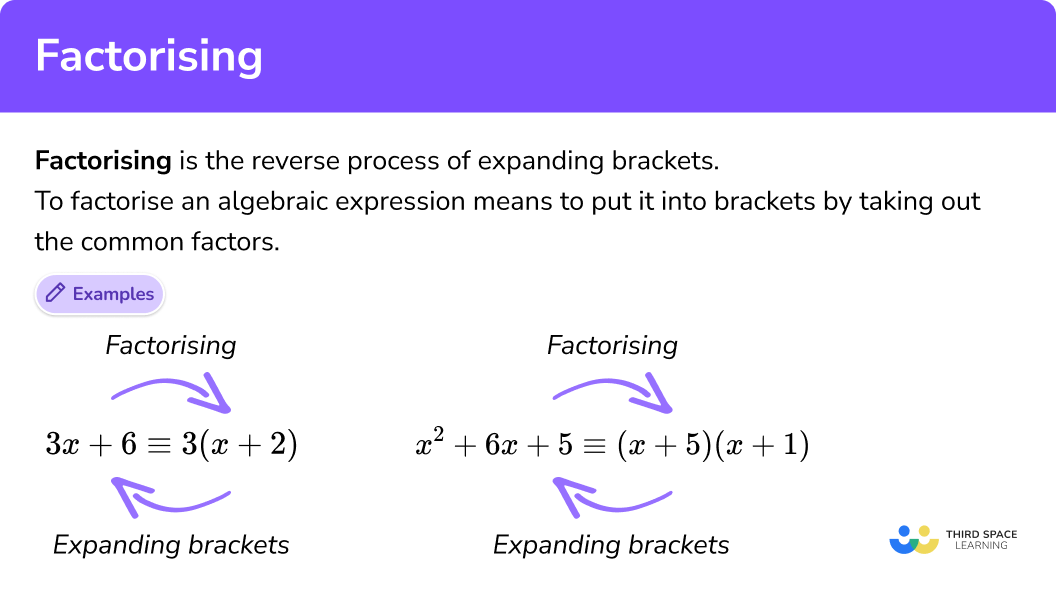
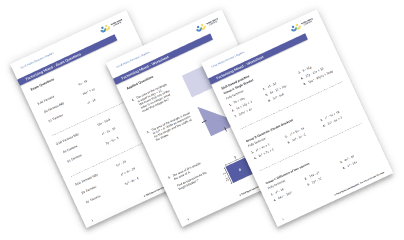
Factorising worksheet

Get your free factorising worksheet of 20+ questions and answers. Includes reasoning and applied questions.
DOWNLOAD FREE
Factorising worksheet

Get your free factorising worksheet of 20+ questions and answers. Includes reasoning and applied questions.
DOWNLOAD FREEHow to factorise expressions
To factorise algebraic expressions there are three basic methods. When you are factorising quadratics you will usually use the double brackets or difference of two squares method.
1. Factorising single brackets
Example of factorising an algebraic expression:
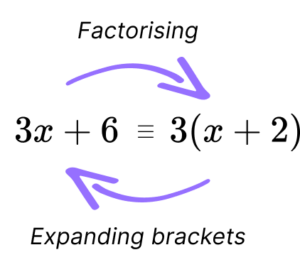
Remember:
2. Factorising double brackets
a) When factorising quadratic expressions in the form
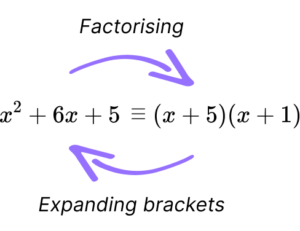
b) When factorising quadratic expressions in the form
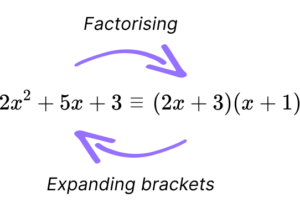
Remember:
Expressions with three terms like
3. Differences of two squares
Using the difference of two squares:
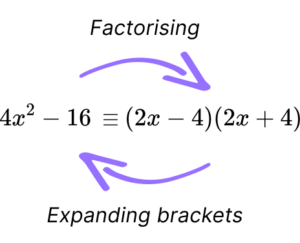
Explain how to factorise expressions
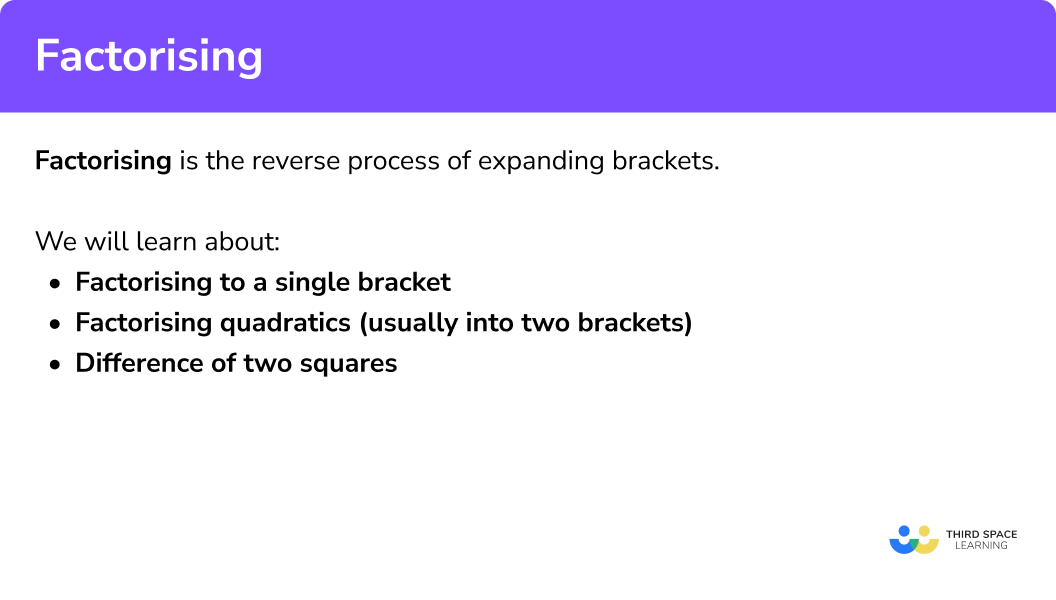
Factorising examples
Each method of factorising or factoring expressions is summarised below. For more detail, practice questions and worksheets on each factorisation example follow the links to the step by step guides.
1. Factorising single brackets
Factorising example using single brackets
To factorise fully:
- Find the highest common factor (HCF) of the numbers
3 (the coefficient ofx ) and6 (the constant).
The highest common factor (HCF) of
2 Write the highest common factor (HCF) at the front of the single bracket.
3 Fill in each term in the bracket by multiplying out.
What do I need to multiply
What do I need to multiply
We can check the answer by multiplying out the bracket!
Step by step guide: Factorising single brackets
2a) Factorising quadratics into double brackets: x2 + bx + c
Factorising example for quadratic expressions in the form
To factorise fully:
- Write out the factor pairs of the last number (
5 )
Factors of 5:
1, 5
2 Find a pair of factors that + to give the middle number (
1 + 5 = 6 ✔ 1 ✕ 5 = 5 ✔
3 Write two brackets and put the variable at the start of each one.
4 Write one factor in the first bracket and the other factor in the second bracket. The order isn’t important, the signs of the factors are.
2b) Factorising quadratics into double brackets: ax2 + bx + c
Factorising example for quadratic expressions in the form
To factorise fully:
- Multiply the end numbers together (
2 and3 ) then write out the factor pairs of this new number in order
Factors of 6:
1, 6
2, 3
2 We need a pair of factors that + to give the middle number (5) and ✕ to give this new number (6)
3 Rewrite the original expression, this time splitting the middle term into the two factors we found in step 2.
4 Split the equation down the middle and factorise fully each half.
5 Factorise the whole expression by bringing whatever is in the bracket to the front and writing the two other terms in the other bracket.
Step by step guide: Factorising quadratics
See also: Quadratic equations
3. Difference of two squares
Factorising example using difference of two squares:
To factorise fully:
- Write down 2 brackets.
2 Square root the first term and write it on the left-hand side of both brackets.
3 Square root the last term and write it on the right-hand side of both brackets.
4 Put + in the middle of one bracket and – in the middle of the other (the order doesn’t matter).
Step by step guide: Difference of two squares
Practice factorising questions (mixed)
1. Fully factorise:
10-5y




The highest common factor of 10 and 5 is 5 . Therefore, we can divide the original expression by 5 , which means the bracket must contain 2-y .
2. Fully factorise:
20{x}^2-8x




The highest common factor of 20x^{2} and 8x is 4x . Therefore, we can divide the original expression by 4x , which means the bracket must contain 5x-2 .
3. Fully factorise:
{x}^2-x-6




In this case, we are looking for numbers that multiply to make -6 and add to make -1 . By considering the factor pairs of -6 , we conclude that we can use +2 and -3 .
4. Fully factorise:
2{x}^2-4x-6




The original expression can be divided by 2 , and then written as a product of two brackets.
2{x}^2-4x-6Divide each term by 2 , and rewrite.
2(x^{2}-2x-3)To factorise the quadratic expression, we are looking for numbers that multiply to -3 and sum to -2 . By considering factor pairs, we conclude that we need to use +1 and -3 .
2(x+1)(x-3)5. Fully factorise:
{x}^2-9




This is a special case (difference of two squares), which means we can take square roots of the coefficient of x and the constant term, then write one bracket with a + sign and the other bracket with a – sign.
6. Fully factorise:
9{x}^2-16




This is a special case (difference of two squares), which means we can take square roots of the coefficient of x and the constant term, then write one bracket with a + sign and the other bracket with a – sign.
Factorising GCSE questions (mixed)
Learning checklist
You have now learnt how to:
-
Manipulate algebraic expressions by taking out common factors to factorise into a single bracket.
-
Factorise quadratic expressions of the form x2 + bx + c
-
Factorise quadratic expressions of the form of the difference of two squares.
-
Factorise quadratic expressions of the form ax2 + bx + c (H)
The next lessons are
Still stuck?
Prepare your KS4 students for maths GCSEs success with Third Space Learning. Weekly online one to one GCSE maths revision lessons delivered by expert maths tutors.

Find out more about our GCSE maths tuition programme.